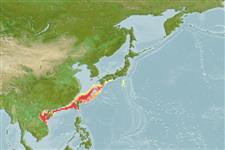Myxini (миксины) (hagfishes) >
Myxiniformes (Hagfishes) >
Myxinidae (Hagfishes) > Eptatretinae
Etymology: Eptatretus: hepta (Gr.), seven; tretos (Gr.), perforated (i.e., with holes), referring to seven gill apertures on what would later be described as Homea banksii (=E. cirrhatus) [range within genus is 6-14 pairs of gill apertures] (See ETYFish); nelsoni: In honor of ichthyologist Gareth J. Nelson (b. 1937), then with the American Museum of Natural History, for contributions to the promotion of phylogenetic systematics (See ETYFish).
Eponymy: Dr Gareth (Gary) Jon Nelson (d: 1937) is Emeritus Curator Vertebrate Zoology, Ichthyology, at the AMNH where he worked for over three decades (1967–1998), having been chairman of ichthyology (1982–1987) and of ichthyology and herpetology (1987–1993) [...] (Ref. 128868), visit book page.
Environment: milieu / climate zone / depth range / distribution range
экология
морской демерсальный; немигрирующий; пределы глубины 50 - 250 m (Ref. 51420). Subtropical
Northwest Pacific: southwest Taiwan.
Length at first maturity / Size / Вес / Возраст
Maturity: Lm 24.0, range 22 - 26 cm
Max length : 25.9 cm TL самец/пол неопределен; (Ref. 51420)
Gill apertures usually 5 (4-6). Slime pores: prebranchial 14-20; branchial 0; trunk 35-39; tail 6-10; total 57-67. Gill apertures nonlinear and crowded.
A dwarf species; males develop testes at about 20 cm and a 22.4 cm female had elongated eggs; a 26.8 cm specimen had eggs 2.4 cm long; and a 24.4 cm specimen had 11 eggs about 1.5 cm long with polar caps already forming (Ref. 51420).
Life cycle and mating behavior
половая зрелость | размножение | нерест | икра | Fecundity | личинки
Copulatory organ absent. The gonads of hagfishes are situated in the peritoneal cavity. The ovary is found in the anterior portion of the gonad, and the testis is found in the posterior part. The animal becomes female if the cranial part of the gonad develops or male if the caudal part undergoes differentiation. If none develops, then the animal becomes sterile. If both anterior and posterior parts develop, then the animal becomes a functional hermaphrodite. However, hermaphroditism being characterised as functional needs to be validated by more reproduction studies (Ref. 51361 ).
Fernholm, B., 1998. Hagfish systematics. p. 33-44. In J.M. Jørgensen, J.P. Lomholt, R.E. Weber and H. Malte (eds.) The biology of hagfishes. Chapman & Hall, London. 578 p. (Ref. 31276)
Статус Красного Списка МСОП (Ref. 130435: Version 2024-1)
Угроза для людей
Harmless
Использование человеком
рыболовство: интереса не представляет
дополнительная информация
инструменты
Специальные отчеты
Скачать в формате XML
ресурсы в Интернет
Estimates based on models
Phylogenetic diversity index (Ref.
82804): PD
50 = 0.5000 [Uniqueness, from 0.5 = low to 2.0 = high].
Bayesian length-weight: a=0.00204 (0.00094 - 0.00444), b=2.93 (2.74 - 3.12), in cm total length, based on LWR estimates for this (Sub)family-body shape (Ref.
93245).
Trophic level (Ref.
69278): 3.9 ±0.7 se; based on size and trophs of closest relatives
устойчивость к внешним воздействиям (Ref.
120179): низкий, минимальное время удвоения популяции 4.5-14 лет (Fec assumed to be <100).
Fishing Vulnerability (Ref.
59153): Low vulnerability (16 of 100).
